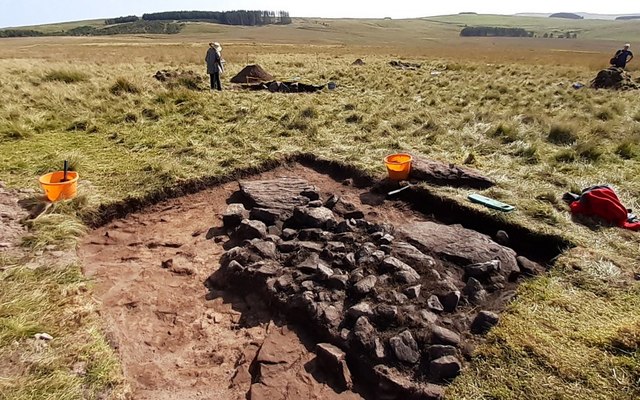Building and works invariably involve moving soil and earth. It is not uncommon to find objects, old footings or walls and even important heritage under the ground.
This NewsFlash looks at important provisions of Heritage Act 2017 (HA) that can concern sub-surface objects and, if not carefully considered in advance, can considerably and unexpectedly delay a works or building project.

The HA protects places containing objects 75 years or older. These are automatically included within the definition of an Archaeological Site.
An ‘archaeological site’ ‘means a place (other than a shipwreck) which –
- Contains an artefact[i], deposit or feature which is 75 or more years old; and
- Provides information of past activity in the State; and
- Requires archaeological methods to reveal information about the settlement, development or use of the place; and
- Is not associated only with Aboriginal occupation of the place’. (S3 HA).
Items less than 75 years old may also be protected if they have ‘archaeological value’ (s130HA). We will look at each of these categories separately below. Neither of the terms ‘archaeological value’ and ‘value’ is defined but HA sets out decision-making elements relevant to ‘archaeological value’ (s130HA).
The Executive Director of Heritage Victoria (ED) must establish and maintain a publicly available Heritage Inventory. The Inventory is to contain all Archaeological Sites, unless an Archaeological Site is determined to have a ‘low archaeological value’ and all approved sites of ‘archaeological value’ (s118HA)[ii] A place that is only associated with Aboriginal occupation is separately protected under the Aboriginal Heritage Act 2006.
More than 75 years old
A person may request that an Archaeological Site be included in the Heritage Inventory. This requires demonstrating that any artefact, deposit or feature at place is over 75 years old. In addition to evidence of age, the place must also provide information of past activity within the State of Victoria (e.g., gold mining).
A request should be accompanied by objective documents evidencing the age. Heritage Victoria is also assisted by images, plans, books and other resources that confirm the age and the manner in which is provides information of past activity in Victoria. A site timeline can be helpful. If there has been an earlier heritage assessment or archaeological survey, that should be included.
Building and Works
If, during buildings or works, there is found an artefact, deposit or feature providing information of past activity in the State of Victoria, a site card must be completed and submitted to Heritage Victoria (HV) within 30 days. Penalties apply. A site card is a prescribed form that includes information as to the location, extent, description, historical background, condition and significance of the find. If a survey is required, HV has Guidelines for Conducting Historical Archaeological Surveys.
Low Archaeological Value
Heritage Victoria has a policy for determining ‘low archaeological value’ that includes two ‘Threshold’ tests – Threshold A (archaeology) and Threshold B (place history).
‘Threshold A (archaeology)
- The place meets the definition of archaeological site under HA; and
- It can be demonstrated that the site contains archaeological features, associated artefacts and/or deposits; and/or
- Documentary evidence and/or oral history, landscape features, visible site fabric or other information indicates a likelihood that the site contains archaeological remains; and
- The archaeological remains are, or are likely to be, in a condition that will allow information to be obtained that will contribute to an understanding of the site; and
Threshold B (place history)
- The site evidences (or is likely to evidence) an association with an historical event, phase, period, process, function, tradition, movement, custom or way of life; and
- The site history is of significance within a state, regional, local, thematic or other relevant framework.’
The ED may recommend to Heritage Council that a place be approved as a Site of Archaeological Value if, in his opinion, the place has archaeological value, provides information of past activity in the State, requires archaeological methods to reveal information about the settlement development or use of the place; and is not associated only with Aboriginal occupation. Submissions must be considered. (s130HA).
Offences and Consents
It is an offence, without the ED’s consent, to knowingly or negligently deface, damage or otherwise interfere with, or carry out an act, likely to endanger a site recorded on the Heritage Inventory or an Archaeological Site (s123HA). This provision operates to avoid the need for an Interim Protection Order or a Stop Order, which apply to other heritage places or objects that are at risk of damage or destruction.
An application for consent is made on the prescribed form and the ED must consider:
- Any relevant archaeological, historical or other research; and
- The potential of the site or archaeological artefact to contribute to such knowledge. (s124(3)HA)
Consent may be issued subject to conditions for supervision, conservation and curation of artefacts found and any other terms and conditions ED considers fit. A right of review exists from the ED’s decision.
KELLEHERS AUSTRALIA PTY LTD
Cameron Algie LLB (Hons), Grad Dip (History), Dr Leonie Kelleher OAM, PhD, Dip TRP, LLB, BA.
31 January 2023
Copyright © Kellehers Australia 2023.
Liability limited by a scheme approved under Professional Standards Legislation
This fact sheet is intended only to provide a summary and general overview on matters of interest. It does not constitute legal advice. You should always seek legal and other professional advice which takes account of your individual circumstances.
[i] ‘archaeological artefact’ ‘means an object (other than a shipwreck artefact) which provides information of past activity in the State and –
- Is associated with an archaeological site; or
- Is associated with a registered archaeological place; or
- Is associated with an approved site of archaeological value; or
- Is associated with a place that was an archaeological site, registered archaeological place or approved site of archaeological value’.
[ii] The Heritage Inventory is separate from the Victorian War Heritage Inventory overseen by the Department of Premier and Cabinet.